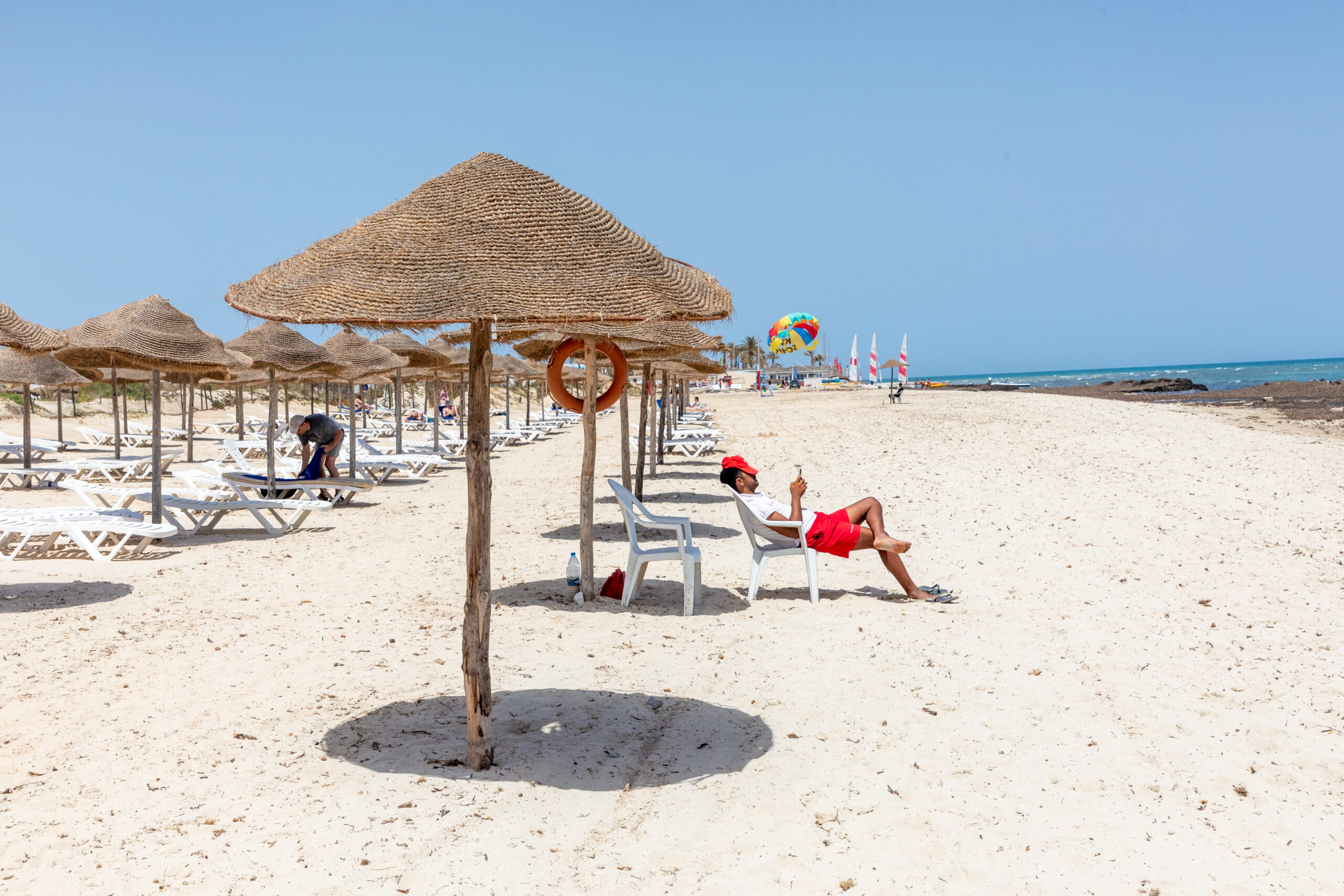Late October in most European capitals means 10-15°C and frequent rain. The idea of swimming in warm-enough water while it’s still possible becomes obsessive. Problem: most European seas are already cold. Spain shows 18°C, Greece 20°C, Malta barely 19°C. To find genuinely swimmable water without flying for five hours, one option remains: Tunisia. Under 3 hours flight from most European capitals, with sea temperatures between 22 and 24°C and reasonable prices.
Tunisia: Europe’s last warm swimming spot in late October
In October, when most Mediterranean destinations shut down, Tunisia holds steady. Water hovers between 23 and 24°C in Djerba, 21 to 23°C in Hammamet. It’s not August’s bath-like warmth, but it’s plenty comfortable for swimming without wincing.
The numbers confirm it: water temperature around 22 degrees in October and, early November, it drops slightly – around 20°C – but remains workable, especially compared to the rest of the Mediterranean.
Tunisia benefits from a particular geographic position. Further south than Malta, with a desert climate softened by the sea, it retains heat longer. Djerba, in the Gulf of Gabès, also benefits from shallow waters that warm up well. Result: you can still swim comfortably when elsewhere, people are already pulling out wetsuits.
Days display 23 to 28°C depending on location. In Djerba, temperatures easily reach 28°C during the day in late October, with clear skies and very little rain. Hammamet runs slightly cooler, around 25°C, but the atmosphere remains summery.
Why Djerba works best
Djerba ticks all boxes. Flight time from major European capitals ranges from 2h30 to 3h direct. Paris is 2h30, London around 3h, Berlin 3h, Rome 2h. Prices stay affordable, even for late October half-term breaks. One finds return flights in the range of affordable to mid-range pricing, decent hotels starting at budget-friendly rates, and restaurant meals at economical prices.
The island maintains its tourist rhythm in October. Hotels stay open, restaurants operate, activities function. Unlike Greece or Spain where everything goes dormant after September, Djerba stays active until November. Beaches are even more pleasant: fewer people, more space, relaxed atmosphere.
Climate-wise, it’s the ideal period. Days reach 23-28°C, nights 15-20°C. Water sits between 21 and 23°C. Sun shines roughly 8 hours daily. Precipitation remains rare, though November starts seeing occasional showers. But we’re talking 3 to 5 rainy days per month, not monsoon season.
Djerba’s 125 kilometers of beaches offer choice. Fine sand beaches, clear water, few waves. Some areas are nearly deserted in October. You can settle in peacefully without fighting for a parasol. Shallow water lets you walk far before losing footing, practical with children.
The value proposition makes all the difference. For the same budget as a weekend in Northern Europe, you get a week in the sun with properly warm sea. Low-cost flights to Djerba are numerous, competition drives prices down. Locally, the cost of living allows indulgence without excessive counting.
Other Tunisian spots for late October
Hammamet attracts those wanting a more urban feel. The resort is well-developed, with a charming medina and decent beaches. Water runs slightly cooler than Djerba – around 21-23°C in October – but it works. Advantage: it’s closer to Tunis if you want to combine beach and cultural visits.
Monastir and Sousse play in the same category. Air temperatures around 26°C, water at 22-23°C, resort atmosphere with some history. Monastir has its ribat and mausoleum, Sousse its UNESCO-listed medina. You can alternate swimming and wandering without getting bored.
The southern coast toward Zarzis remains more discreet. Water runs as warm as Djerba, sometimes even a degree warmer, but infrastructure is less developed. If you’re after absolute quiet and basic comfort suffices, it might be worth it. Otherwise, stick with Djerba.
Practical details
Pack a windbreaker or light sweater anyway. Evenings can be cool, especially early November. Mornings too, sometimes 12-15°C at wake-up. But by 10am, the sun hits and summer temperatures return. This temperature range makes the period pleasant: neither too hot during the day, nor stifling at night.
The weather pattern stays stable throughout October. Clear skies dominate, rain remains exceptional. Wind can pick up some afternoons, particularly on exposed beaches, but nothing dramatic. Water stays calm, waves remain gentle except during rare stormy episodes.
Sunscreen remains essential despite the season. The sun still packs punch at this latitude. UV levels drop compared to summer but stay significant. One hour at midday without protection still burns Northern European skin.
October marks low season in Tunisia, meaning fewer crowds but also some services running reduced schedules. Most tourist areas stay fully operational, but remote spots might see limited restaurant hours or closed facilities. Djerba and major resorts avoid this issue entirely.

